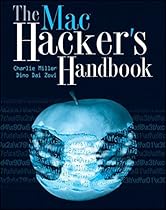The Mac Hacker's Handbook

| Author | : | |
| Rating | : | 4.90 (775 Votes) |
| Asin | : | 0470395362 |
| Format Type | : | paperback |
| Number of Pages | : | 384 Pages |
| Publish Date | : | 2013-08-03 |
| Language | : | English |
DESCRIPTION:
This unique tome is the first book to uncover the flaws in the Mac OS X operating system—and how to deal with them. Written by two white hat hackers, this book is aimed at making vital information known so that you can find ways to secure your Mac OS X systems, and examines the sorts of attacks that are prevented by Leopard’s security defenses, what attacks aren’t, and how to best handle those weaknesses.. As more and more vulnerabilities are found in the Mac OS X (Leopard) operating system, security researchers are realizing the importance of developing proof-of-concept exploits for those vulnerabilities
CharlIe Millerwon the second CanSecWest Pwn2Own contest in 2008 and was named one of the Top 10 Computer Hackers of 2008 by Popular Mechanics.Dino Dai Zovi won the first CanSecWest Pwn2Own contest in 2007 and was named one of the 15 Most Influential People in Security by eWEEK.
Good book but needs an update Zachary Cutlip The Mac Hacker's Handbook covers a lot of useful technical topics surrounding vulnerability analysis and exploit development for Mac OS X. That said, it doesn't so much teach you directly, as guide your learning. For example, it introduces the use of DTrace on OS X for dynamic analysis. It makes a very good case for DTrace's usefulness in reverse engineering, and for you to go out on your own and learn about it. Its DTrace examples aren't really freestan. Fantastic book for understanding details of Mac OSX Chris Marlowe Well-written, readable, and fascinating, Charlie and Dino describe what goes on under the covers of Mac OS X, warts and all. They explain the obscure, badly-documented, and unsupported. Well worth reading for anyone who wants to know what's under the covers.. The best Mac security reference The Mac Hacker's Handbook is the best reference for Mac-specific attack information that I have found. At 368 pages, it may appear small compared to the typical 750+ page security tome. That's because the authors have done a near-perfect job of sticking to the topic at hand, the Mac. The authors do not succumb to the usual temptation to try and teach assembly language or reverse engineering. Rather, they do an excellent job touching on those topics in an
If you manage security for a network that includes OS X machines, this update on the strengths and weaknesses of Mac OS X is required reading.Beginning with the core differences between Mac OS X and Windows or Linux, this book follows the steps an attacker would take. When you know how they get in, you'll know how to keep them out.See what makes Mac OS® X unique, what security improvements were added with Leopard®, and where vulnerabilities lieExplore uncommon protocols—Bonjour®, the QuickTime® file format, and RTSPLook for bugs in Apple's source code or use a black box technique such as fuzzingExamine stack overflow and heap overflow attacks directed at PowerPC and x86 architectures, as well as shellcodes and payloadsLearn to inject code into running processes and how attackers use this techniqueUnderstand Mac OS X-specific rootkit techniques. You will learn the tools needed to find vulnerabil
